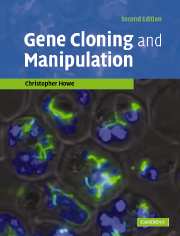Book contents
- Frontmatter
- Contents
- Preface to first edition
- Preface to second edition
- Chapter 1 The tools for the job
- Chapter 2 Polymerase chain reaction
- Chapter 3 Simple cloning
- Chapter 4 Other vector systems for E. coli
- Chapter 5 Making libraries
- Chapter 6 Screening libraries
- Chapter 7 Modification and mutagenesis
- Chapter 8 Use of cloned DNA
- Chapter 9 Using other organisms
- Chapter 10 Examples
- References
- Index
- Frontmatter
- Contents
- Preface to first edition
- Preface to second edition
- Chapter 1 The tools for the job
- Chapter 2 Polymerase chain reaction
- Chapter 3 Simple cloning
- Chapter 4 Other vector systems for E. coli
- Chapter 5 Making libraries
- Chapter 6 Screening libraries
- Chapter 7 Modification and mutagenesis
- Chapter 8 Use of cloned DNA
- Chapter 9 Using other organisms
- Chapter 10 Examples
- References
- Index
Summary
Introduction
The aim of this chapter is to show you how the different techniques we have covered in the preceding chapters can be put together to study biological systems. Some examples of things you might want to do will be given, and strategies will be suggested for achieving those aims. It may be helpful to read the description of the problem first, design your solution and then compare it with the suggested one. It is important to realize that there is rarely a single ‘correct’ answer. There may be other equally suitable strategies in addition to the ones suggested here.
Scenario 1
(a) You are studying a bacterium that grows in a particular ecological niche. You cannot culture it in the laboratory, but you can isolate small quantities of cells that microscopic analysis indicates are not contaminated with other bacteria. You want to obtain ribosomal RNA gene sequence data to study the taxonomy of the bacterium.
You could use PCR with primers to regions of ribosomal RNA genes that are conserved across a wide range of bacteria to amplify the corresponding sequences from the bacterium of interest. If the PCR product looked sufficiently specific (i.e. it appeared to be a single band in gel electrophoresis) and was in sufficient quantity, then you could determine its DNA sequence directly.
Information
- Type
- Chapter
- Information
- Gene Cloning and Manipulation , pp. 243 - 249Publisher: Cambridge University PressPrint publication year: 2007
